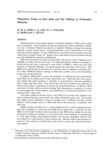Plantation Trials on Bris Soils and Tin Tailings in Peninsular Malaysia
JIRCAS international symposium series
| ISSN | 13406108 |
|---|---|
| 書誌レコードID(総合目録DB) | AA1100908X |

本文フルテキスト
intlsymp-1_147-157.pdf424.92 KB
Plantation trials of some selected species in Peninsular Malaysia on BRIS and tin tailing soils are presented. Acacia mangium has been the single species widely established as plantation crop. Peninsular Malaysia has planned to establish 188,255ha of fast-growing species based on a 15-year rotation period. It was estimated that a yield of 39.64 million m3 of wood materials could be obtained. To date 42,500ha have been planted with this species, where the oldest stand is already 10 years old. Besides Acacia, some selected tropical hardwood species have been identified for plantation establishment.
BRIS soils which form an almost continuous belt along the east coast of Malaysia cover 162,000ha or 1.23% of the total land mass. Tin tailing soil includes residues of tin mining activities and this soil type is estimated to cover around 113,700ha or nearly 1% of the total land mass of Peninsular Malaysia. It is mainly found in the central part of the country. Both BRIS and tin tailing soils are inherently low in fertility and are considered as problem soils.
As a result, FRIM has devised a strategy to utilize these problem soils for the afforestation program for timber production.
In addition, FRIM plans to explore the possibility of stabilizing the micro-environment under BRIS and tin tailing soils for future agroforestry use. These soils have been successfully planted with Acacia mangium, A. aulocarpa, A. aucuriculiformis, Casuarina equiselifolia,Pinus caribaea and Pinus ellotii. Some success has also been recorded in the production of bamboo shoots using a combination of organic and compound fertilizers. In addition, FRIM also plans to initiate studies on nutrient cycling, litter decomposition, introduction of rattan as intercropping with Acacia mangium, and establishment of commercial plantations of Cinnamomum spp. on these soils.
This paper outlines the fertility status of the BRIS and tin tailing soils compared with some prominent Malaysian soils derived from widely distributed parent rocks. Such studies may enable a better assessment of these two problem soils. In addition, the foliar nutrient status of Acacia mangium grown on BRIS soils will be also presented in comparison with other soils.
Height, diameter and basal area of Acacia mangium grown on various geological formations will be presented in comparison with BRIS and tin tailing soils. In addition, the MAI (dbh) and total height of selected species planted on both BRIS and tin tailing soils are also presented for comparative purposes. It was observed that Acacia mangium, A. auriculiformis, A. richii, Pinus caribaea, Paraserienthesis falcataria and Casuarina equiselifolia offered a definite potential for reafforestation of these problem soils. Bambusa vulgaris also showed a potential for culm production provided that certain levels of organic and compound fertilizers were applied.
BRIS soils which form an almost continuous belt along the east coast of Malaysia cover 162,000ha or 1.23% of the total land mass. Tin tailing soil includes residues of tin mining activities and this soil type is estimated to cover around 113,700ha or nearly 1% of the total land mass of Peninsular Malaysia. It is mainly found in the central part of the country. Both BRIS and tin tailing soils are inherently low in fertility and are considered as problem soils.
As a result, FRIM has devised a strategy to utilize these problem soils for the afforestation program for timber production.
In addition, FRIM plans to explore the possibility of stabilizing the micro-environment under BRIS and tin tailing soils for future agroforestry use. These soils have been successfully planted with Acacia mangium, A. aulocarpa, A. aucuriculiformis, Casuarina equiselifolia,Pinus caribaea and Pinus ellotii. Some success has also been recorded in the production of bamboo shoots using a combination of organic and compound fertilizers. In addition, FRIM also plans to initiate studies on nutrient cycling, litter decomposition, introduction of rattan as intercropping with Acacia mangium, and establishment of commercial plantations of Cinnamomum spp. on these soils.
This paper outlines the fertility status of the BRIS and tin tailing soils compared with some prominent Malaysian soils derived from widely distributed parent rocks. Such studies may enable a better assessment of these two problem soils. In addition, the foliar nutrient status of Acacia mangium grown on BRIS soils will be also presented in comparison with other soils.
Height, diameter and basal area of Acacia mangium grown on various geological formations will be presented in comparison with BRIS and tin tailing soils. In addition, the MAI (dbh) and total height of selected species planted on both BRIS and tin tailing soils are also presented for comparative purposes. It was observed that Acacia mangium, A. auriculiformis, A. richii, Pinus caribaea, Paraserienthesis falcataria and Casuarina equiselifolia offered a definite potential for reafforestation of these problem soils. Bambusa vulgaris also showed a potential for culm production provided that certain levels of organic and compound fertilizers were applied.
| 作成者 | H. M. S. AMIR L. H. ANG W. C. SUHAIMI H. MOHD A. AZLAN |
|---|---|
| 公開者 | Japan International Research Center for Agricultural Sciences |
| オンライン掲載日 | |
| 号 | 1 |
| 開始ページ | 147 |
| 終了ページ | 157 |
| 言語 | eng |
